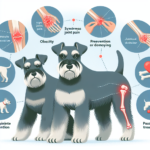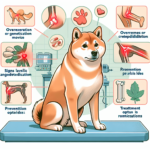Boxer Joint Pain: Causes, Symptoms, Prevention, and Treatment

Introduction
Boxers are a beloved breed known for their playful and energetic nature. Originating in Germany in the late 19th century, Boxers were initially bred for hunting and guarding. They are medium to large-sized dogs with a muscular build, short coat, and distinctive square muzzle. Boxers are highly intelligent, loyal, and make excellent family pets due to their affectionate and protective nature.
Despite their robust appearance, Boxers are prone to several health issues, including heart conditions, cancer, and joint problems. Joint pain is a significant concern for Boxers, as it can severely impact their quality of life. Maintaining joint health is crucial for Boxers to ensure they remain active and happy throughout their lives.
Breed-Specific Joint Pain Risks
Genetic Predisposition
Boxers have a genetic predisposition to several joint-related issues, including hip dysplasia, arthritis, and elbow dysplasia. Hip dysplasia is a condition where the hip joint does not fit properly into the hip socket, leading to pain and mobility issues. Elbow dysplasia involves abnormal development of the elbow joint, causing lameness and discomfort. Arthritis, a degenerative joint disease, is also common in Boxers, leading to chronic pain and stiffness.
Age-Related Risks
As Boxers age, the risk of developing joint pain increases. Typically, joint issues may start to appear in middle age, around 5 to 7 years old. However, some Boxers may show signs of joint problems earlier, especially if they have a genetic predisposition. Senior Boxers, aged 8 years and older, are particularly vulnerable to arthritis and other degenerative joint conditions.
Activity Level and Joint Stress
Boxers are known for their high energy levels and love for physical activities such as running, jumping, and playing. While regular exercise is essential for their overall health, excessive or high-impact activities can put stress on their joints, leading to wear and tear over time. Boxers involved in activities like agility training or those used as working dogs may be at a higher risk of joint stress and subsequent pain.
Common Symptoms of Joint Pain in Boxers
General Symptoms
- Limping or favoring one leg
- Stiffness, especially after rest or sleep
- Reluctance to move, jump, or climb stairs
- Decreased activity level or interest in play
- Visible discomfort or pain when touched
- Swelling around the joints
Breed-Specific Symptoms
In Boxers, joint pain may manifest as a noticeable change in their gait, often described as a “bunny hop” when running. They may also show a reluctance to engage in activities they previously enjoyed, such as playing fetch or going for long walks. Owners may observe their Boxer struggling to get up from a lying position or showing signs of discomfort when lying down.
When to Consult a Vet
If you notice any of the above symptoms in your Boxer, it is essential to consult a veterinarian promptly. Early diagnosis and intervention can help manage joint pain more effectively and improve your dog’s quality of life. Persistent limping, severe pain, or any sudden changes in behavior warrant immediate veterinary attention.
Preventive Measures for Joint Health
Exercise Recommendations
Regular, moderate exercise is crucial for maintaining joint health in Boxers. Activities such as walking, swimming, and low-impact play are ideal. Avoid high-impact exercises like excessive running or jumping, which can strain the joints. Consistent, gentle exercise helps keep the muscles strong and supports joint function.
Dietary Suggestions
A balanced diet rich in essential nutrients is vital for joint health. Consider incorporating foods or supplements that contain glucosamine, chondroitin, and omega-3 fatty acids, which support joint health and reduce inflammation. Consult your veterinarian for specific dietary recommendations tailored to your Boxer’s needs.
Weight Management
Maintaining a healthy weight is crucial for reducing joint stress. Overweight Boxers are at a higher risk of developing joint problems due to the additional strain on their joints. Monitor your Boxer’s weight and adjust their diet and exercise routine as needed to keep them at an optimal weight.
Early Screening and Monitoring
Regular veterinary check-ups are essential for early detection of joint issues. Screening tests such as X-rays or joint fluid analysis can help identify problems before they become severe. Early intervention can significantly improve outcomes and slow the progression of joint diseases.
Treatment Options for Joint Pain
Non-Surgical Treatments
Non-surgical treatments for joint pain in Boxers include medications, physical therapy, and lifestyle adjustments. Anti-inflammatory drugs and pain relievers can help manage pain and reduce inflammation. Physical therapy, including exercises and massage, can improve joint function and mobility. Lifestyle adjustments, such as providing a comfortable bed and avoiding high-impact activities, can also alleviate joint pain.
Surgical Options
In severe cases, surgical intervention may be necessary. Common surgeries for joint pain in Boxers include hip replacement, arthroscopy, and joint fusion. These procedures can provide significant pain relief and improve mobility. However, surgery should be considered a last resort after exploring all non-surgical options.
Alternative Therapies
Alternative treatments such as acupuncture, hydrotherapy, and massage can benefit Boxers with joint pain. Acupuncture involves inserting thin needles into specific points on the body to relieve pain and improve function. Hydrotherapy, or water therapy, provides low-impact exercise that supports joint health. Massage can help reduce muscle tension and improve circulation, promoting joint health.
Lifestyle and Management Tips
Daily Care Routine
A daily care routine for a Boxer with joint pain should include gentle exercise, a balanced diet, and regular veterinary check-ups. Incorporate low-impact activities like walking and swimming into their routine. Provide a comfortable, supportive bed and avoid high-impact activities that can strain their joints.
Modifying the Home Environment
Making your home more comfortable for a Boxer with joint pain can significantly improve their quality of life. Consider using ramps instead of stairs, providing orthopedic beds, and ensuring they have easy access to food and water. Avoid slippery surfaces that can cause falls and further joint damage.
Long-Term Management
Long-term management of joint pain in Boxers involves regular monitoring, consistent exercise, and a balanced diet. Work closely with your veterinarian to develop a comprehensive care plan tailored to your Boxer’s needs. Regular check-ups and early intervention can help manage joint pain effectively and keep your Boxer active and happy.
FAQs About Boxers and Joint Pain
What are the early signs of joint pain in Boxers?
Early signs of joint pain in Boxers include limping, stiffness, reluctance to move, and decreased activity levels. If you notice any of these symptoms, consult your veterinarian promptly.
Can joint pain in Boxers be prevented?
While genetic predisposition cannot be changed, you can take preventive measures to reduce the risk of joint pain. These include regular, moderate exercise, a balanced diet, maintaining a healthy weight, and regular veterinary check-ups.
Are there specific diets that can help with joint health in Boxers?
Yes, diets rich in glucosamine, chondroitin, and omega-3 fatty acids can support joint health. Consult your veterinarian for specific dietary recommendations tailored to your Boxer’s needs.
When should I consider surgery for my Boxer’s joint pain?
Surgery should be considered a last resort after exploring all non-surgical options. If your Boxer has severe pain that is not managed by medications or physical therapy, consult your veterinarian to discuss surgical options.
What alternative therapies are available for Boxers with joint pain?
Alternative therapies such as acupuncture, hydrotherapy, and massage can benefit Boxers with joint pain. These treatments can help reduce pain, improve mobility, and support overall joint health.
Conclusion
Joint pain is a significant concern for Boxers, but with proper care and preventive measures, you can help your Boxer maintain healthy joints and enjoy a high quality of life. Regular exercise, a balanced diet, weight management, and early screening are crucial for preventing and managing joint pain. If your Boxer shows signs of joint pain, consult your veterinarian promptly to develop an effective treatment plan. By taking proactive steps, you can ensure your Boxer remains active, happy, and pain-free.




